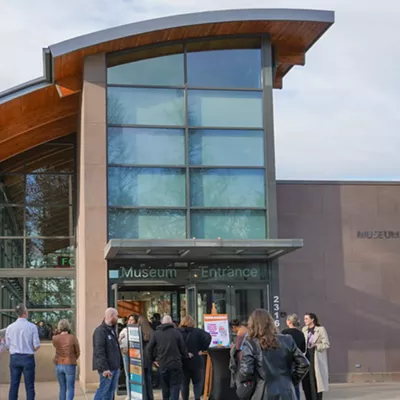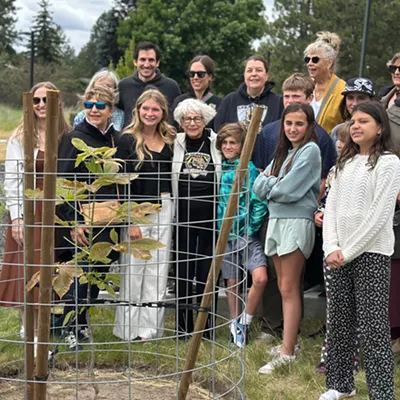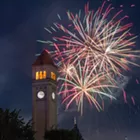Interest in Japanese culture seems to be at an all-time high, even in a land-locked city like Spokane. Maybe it's the popularity of Lost in Translation or even Maximum Extreme Challenge. Maybe it's the gradual influence of Japanese pop culture in our video games, our fashion, our Hello Kitty desk lamps and Batz-maru cell phone covers. Locally, it could have a lot to do with the work of Mukogawa Fort Wright Institute and its Japanese Cultural Center, which have been a big part of Japan Week for 12 years now.
It's fitting that 2004 is the Year of the Monkey. This sign in the Asian zodiac embodies the characteristics of curiosity, playfulness and humor, and this year's Japan Week has numerous opportunities to explore, to learn, to watch and to just have fun. From Japanese martial arts like kendo and aikido to events at the Spokane Buddhist Temple, from origami story times to the screening of a new documentary, Japan Week really strives to have something for everyone. For more information on events not listed here, please call Mukogawa Fort Wright Institute at 328-2971.
Bonsai
The 1984 film The Karate Kid was where thousands of Americans learned that bonsai, the Japanese art of growing trees in pots, was pronounced BONE-sigh, not BAHN-zai. (The latter is a cheer.)
Unfortunately, the film offered little else in the way of explaining this strange art, and small trees started appearing in grocery stores and nurseries across the country. Many of these were nothing more than dying junipers stuck into a tray of pebbles, or not-very-successful attempts at producing dwarf trees by simply planting them in pots.
Real bonsai are something else entirely. Standing as high as several feet tall, or as low as several inches, a carefully tended bonsai manages to give viewers the sensation that they are in the presence of a venerable, towering tree. Bonsai growers meticulously trim the roots and branches of their plants, encouraging them to mature in small trays. Their branches are shaped by wire twisted gently around them, and moss or rocks are often placed on the soil beneath the leaves, creating the impression of a landscape done in miniature.
Not all of the potency that these trees have is man-made, however. The bonsai itself is still a tree, subject to the needs, mysteries, and timeline of nature. A person may be able to make a dwarf tree in several years, but that tree might still require decades to mature. Of course, it won't grow much bigger. But the signs of age will begin to enhance the tree subtly: the bark will occasionally split, old branches will die, tangled roots will begin to erupt from the ground. Far from detracting from the tree's beauty, however, these features lend it character and power. A miniature tree sitting in a room in which it is the oldest living being is both humbling and encouraging.
The fact that bonsai are trees also explains why there is no single school of technique for practicing the art. Anyone who makes a bonsai undertakes the protection of that tree for the rest of its life. If artists limit themselves to one style or technique, they risk ignoring the inherent qualities of the living thing under their care. The tree's nature determines, as much as the artist's craft, what the final bonsai will look like. For bonsai enthusiasts, this can mean decades of listening to the slow language of nature and responding with skill, imagination, and artistry.
"Echo of the East" opening reception, Saturday, April 17, from noon-4 pm at the Corbin Art Center, 507 W. Seventh Ave. (exhibit will be on view through May 22) * Also, the Inland Empire Bonsai Society will demonstrate and display their craft at the SCC Lair, Littlefoot Lounges A & amp; B, on Monday, April 19, at 10:30 am.
Sushi
One of the coolest picture books I've ever seen on Japanese-American acclimation would have to be Yoko, by Rosemary Wells. It's the first day of school and Yoko proudly carries her homemade lunch, a small Japanese cooler full of rice rolls containing "the crispiest cucumber, the pinkest shrimp, the greenest seaweed, and the tastiest tuna." Which is all fine and good until Yoko's peanut butter-and-jelly eating classmates loudly gross out over her "weird" lunch. Yoko's teacher recognizes a learning opportunity when she sees it, and schedules an "international day" so that everyone can bring foods from other cultures for their classmates to try. Not only do the other kids find that they like sushi, but Wells' book is delightfully influenced by Japanese culture -- from the little paintings of different kids of sushi on the end pages to the cherry blossom-patterned origami paper motifs.
If you've never had sushi, one of the first things you discover upon trying some is how remarkably un-fishy it tastes. Really fresh raw fish, prepared by a well-trained sushi master, tastes buttery, clean and slightly sweet. The most popular form of sushi in the United States is undoubtedly the maki, or rolled, sushi. Vinegared rice and bits of vegetable and fish are rolled inside thin sheets of nori (seaweed). There are many variations, including the California and Philly rolls (containing avocado and cream cheese, respectively), and rolls containing cucumber, carrots, crab, shrimp, tuna, mackerel or even in some homemade varieties, SPAM. Sashimi, which is simply delicate morsels of sliced raw fish served over thumb-sized humps of vinegared rice, is also very popular.
While sushi is a remarkably healthy and delicious food, half of its appeal lies in the ritual of eating it. It's usually ordered with a cup of miso soup, and after drinking the soup (tea fashion), you prepare your condiments. Chopsticks are used to mix the green wasabi and soy sauce into a salty/hot sauce, while transparent little leaves of pickled ginger are gently lifted on top of the maki and (hopefully) stay there as you transfer the entire little package to the sauce and then to your mouth.
Of course there are many other kinds of sushi -- and customs -- too numerous to go into here, but Japan Week offers several great opportunities to sample this gorgeous, addictive little food.
"Yum Yum Sushi," a sushi demonstration and sale sponsored by the SFCC International Club, takes place on Tuesday, April 20, from 11:30 am-1 pm at SFCC's SUB Lounge C. Call 533-3367 * Whitworth College sponsors a Japanese dinner on April 20 from 5:30-7 pm. Tickets: $8. Reservations only. Call 777-4282 * The Highland Park United Methodist Church's annual Sukiyaki Dinner is Saturday, April 24, from noon-7 pm, featuring exhibits, crafts and a sushi bar. Cost: $10. Call 535-2687
Japanese Art
In her beautiful book Kindness, Spokane author Sarah Conover relates a Buddhist question: "The beauty of the mountain colors; / What could it have to do / With being right or wrong?"
Even though the quotation derives from a Chinese story, the question it asks is very Japanese: What is the significance of things like color, design, and pattern? Japanese art reminds us that the artist must treat every mark made as a decision between right and wrong, not just between black and white.
The popular style of wood block prints known as ukiyo-e is perhaps the most familiar example of the beauty that this sense of mindfulness yields. Famous ukiyo-e depict notable kabuki actors and celebrated courtesans in bold colors and simple, elegant lines. But there is also a large body of ukiyo-e prints that document daily life in Japan, since the art form was accessible (and affordable) by the middle class. Regardless of their subject, however, ukiyo-e artists had to balance the need to depict a scene accurately while creating an overall balance of color, shape, and line. Artists were considered especially skilled when they were able to include a maximum number of details in a print without sacrificing the basic qualities that made the print pleasing to look at.
But scrolls of calligraphy or early Japanese cartoons can often be shockingly free. It's not unusual to encounter an ancient ink painting by a Buddhist master that looks simply like shapes and swirls on a scroll. In these cases, much of the artistry lies in the way artists used their brushes. Certain hazy lines can make figures appear distant or indistinct, for example, allowing the artist to paint things like ghosts and snowstorms with uncanny skill. Bolder and sloppier lines, through their curving and twisting, suggest the nimble motions of an acrobat. These paintings have given rise in recent years to major Japanese artists designing anime and video game characters that display the same flat appearance and simple design. Some young modern Japanese artists have even started calling their work "super-flat," because their ability to capture character, mood, and setting doesn't depend on the Western ideals of perspective and verisimilitude.
That's not to say that Japanese art is free of perspective or detail. Watercolor paintings, for example, often depict a single tree or mountainside up close. The wash of color and darkness that covers most of the work creates an unfathomable depth in which the viewer can be lost. But a few sharp ink lines defining a cliff or branch can send the viewer on a visual search for more clues. Instead of simply painting a picture of a bird sitting in a tree for us to judge, a Japanese painter might make us undertake the search for that bird. Consequently, the experience of looking at much Japanese art is more akin to watching nature than assessing a painting. It's often easier to see the work - whether it's a calligraphy scroll or an enormous ukiyo-e print -- in terms of nature than art.
"Echo of the East," featuring traditional Japanese watercolors, sumi-e, silk embroidery and more, has an opening reception, Saturday, April 17, from noon-4 pm at the Corbin Art Center, 507 W. Seventh Ave. (The exhibit will be on view through May 22.) * A Sumi-e Invitational Art Reception takes place at SFCC's Gallery of Art on Tuesday, April 20, from 11 am-2 pm. (The exhibit runs through May 20.) Call 533-3710.
Origami
If you've ever folded a plain sheet of paper into a crane, a small box, even one of those fortune-telling devices that reveals who among your fellow fifth-graders you're going to marry - you've practiced the art of origami. This Japanese art form is hundreds of years old and is as simple - or complicated - as folding paper into shapes. Japanese legend has it that if you fold a thousand paper cranes, your wish will be granted. (Ellen Coerr's book Sadako and the Thousand Paper Cranes is a particularly poignant story related to this legend.)
While origami is one of those things many Japanese and American schoolchildren learn at some point in their young educational careers, it has also grown to become a serious art form. There are many practitioners on the Web, from freelance "paper engineers" to contemporary artists who recently participated in an origami show at the Bauhaus.
One of the best ways to practice origami during Japan Week is to grab the kids (or borrow some nieces and nephews) and sit in on one of Patrice Pendell's story times. Pendell, activity coordinator of the Japanese Cultural Center at Mukogawa Fort Wright Institute, is a gifted storyteller who incorporates both origami and kamishibai in her presentations. Kamishibai is a traditional Japanese storytelling form that involves a wooden, shuttered board and picture cards. It might sound complicated, but the sliding doors and revealed pictures have a way of riveting even the squirmiest youngsters. Pendell sometimes brings Japanese newspapers to fold, which adds another delightful Japanese culture element to the mix. It's definitely worth checking out.
Japanese Kamishibai and Origami with Patrice Pendell at Auntie's Bookstore, 402 W. Main Ave., on Saturday, April 17, from 10:30-11:30 am Call 838-0206 * School-Age Story Time with Patrice Pendell on Tuesday, April 20, at 4:15 pm at the East Side Library, 524 S. Stone St. Call 444-5375 * Preschool-Age Story Time with Patrice Pendell on Thursday, April 22, at 10:30 am at the Hillyard Library, 4005 N. Cook St. Call 444-5380.
Publication date: 04/15/04















